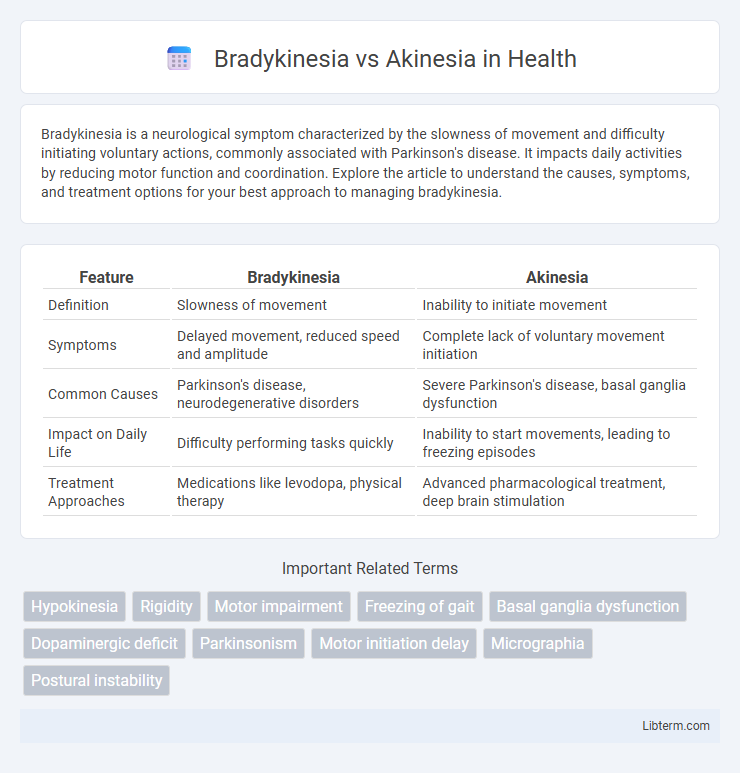Bradykinesia is a neurological symptom characterized by the slowness of movement and difficulty initiating voluntary actions, commonly associated with Parkinson's disease. It impacts daily activities by reducing motor function and coordination. Explore the article to understand the causes, symptoms, and treatment options for your best approach to managing bradykinesia.
Table of Comparison
| Feature | Bradykinesia | Akinesia |
|---|---|---|
| Definition | Slowness of movement | Inability to initiate movement |
| Symptoms | Delayed movement, reduced speed and amplitude | Complete lack of voluntary movement initiation |
| Common Causes | Parkinson's disease, neurodegenerative disorders | Severe Parkinson's disease, basal ganglia dysfunction |
| Impact on Daily Life | Difficulty performing tasks quickly | Inability to start movements, leading to freezing episodes |
| Treatment Approaches | Medications like levodopa, physical therapy | Advanced pharmacological treatment, deep brain stimulation |
Understanding Bradykinesia and Akinesia
Bradykinesia refers to the slowness of movement, characterized by delayed initiation and reduced amplitude of voluntary motions, often seen in Parkinson's disease. Akinesia is the absence or difficulty in initiating movement, presenting as a more severe motor impairment that can lead to freezing episodes. Distinguishing between bradykinesia and akinesia is crucial for accurate diagnosis and tailored treatment strategies in neurodegenerative disorders.
Definitions: Bradykinesia vs Akinesia
Bradykinesia refers to the slowness of voluntary movement, characterized by reduced speed and amplitude of motion, commonly observed in Parkinson's disease. Akinesia, in contrast, denotes the absence or loss of voluntary movement initiation, often presenting as freezing or difficulty in beginning motion. Both symptoms reflect motor impairment but differ intensively; bradykinesia involves delayed execution, whereas akinesia entails a near-complete inability to start movement.
Clinical Features and Symptoms
Bradykinesia is characterized by slowness of movement and difficulty initiating voluntary motor tasks, often observed in Parkinson's disease, with symptoms including reduced amplitude and speed of repetitive movements. Akinesia refers to the loss or absence of movement, presenting clinically as a difficulty or inability to initiate movement, leading to a frozen or rigid state. Both conditions impact motor function but differ in severity and manifestation, with bradykinesia causing slowed actions and akinesia causing near or complete movement cessation.
Neurological Mechanisms Involved
Bradykinesia is characterized by slowed movement primarily due to impaired activation of motor circuits in the basal ganglia, particularly involving dopamine depletion in the substantia nigra affecting the direct and indirect pathways. Akinesia represents the complete absence or freezing of movement, linked to severe disruption of cortical-basal ganglia-thalamocortical loops that impair motor initiation. Both conditions reflect dysfunction in dopaminergic neurotransmission and altered activity in the motor cortex and supplementary motor area, but akinesia denotes a more profound failure in motor command execution.
Common Causes and Risk Factors
Bradykinesia and akinesia are motor symptoms primarily caused by neurological disorders such as Parkinson's disease, characterized by dopamine depletion in the basal ganglia. Common risk factors include advancing age, genetic predisposition, and exposure to neurotoxins like MPTP or manganese. Both conditions can also result from secondary causes such as stroke, brain trauma, or medication-induced parkinsonism.
Diagnostic Approaches and Criteria
Diagnostic approaches for bradykinesia emphasize clinical observation of slowness in movement initiation and execution, often utilizing the Unified Parkinson's Disease Rating Scale (UPDRS) to quantify severity. Akinesia diagnosis centers on identifying the absence or marked reduction of voluntary movements, assessed through patient history and specific motor tests evaluating movement initiation failure. Neuroimaging techniques like dopamine transporter (DAT) scans assist in differentiating these conditions by revealing presynaptic dopaminergic deficits characteristic of Parkinsonian syndromes.
Bradykinesia in Parkinson’s Disease
Bradykinesia, a core motor symptom of Parkinson's Disease, manifests as slowed movement and difficulty initiating voluntary actions, significantly impairing daily activities. It results from the degeneration of dopaminergic neurons in the substantia nigra, disrupting the basal ganglia circuits responsible for motor control. Unlike akinesia, which refers to the complete absence of movement, bradykinesia involves reduced movement amplitude and speed but with preserved motor intention.
Akinesia in Neurological Disorders
Akinesia, characterized by the complete absence or difficulty in initiating voluntary movement, is commonly observed in neurological disorders such as Parkinson's disease and progressive supranuclear palsy. This motor deficit results from disruptions in basal ganglia circuits, specifically involving dopamine depletion, which impairs the initiation of movement at a neural level. Unlike bradykinesia, which manifests as slowness of movement, akinesia reflects a more profound motor initiation failure, critically impacting patients' mobility and quality of life.
Treatment and Management Strategies
Bradykinesia and akinesia, common symptoms of Parkinson's disease, require tailored treatment strategies to improve motor function and quality of life. Levodopa remains the cornerstone therapy, enhancing dopamine levels to reduce slowness of movement and difficulty initiating motion. Complementary approaches include physical therapy focusing on repetitive, rhythmic exercises, and deep brain stimulation for advanced cases unresponsive to medication.
Key Differences and Prognostic Implications
Bradykinesia involves a marked slowness in initiating and executing voluntary movements, while akinesia refers to the complete absence or inability to initiate movement, representing a more severe motor deficit. Bradykinesia often manifests as reduced amplitude and speed of repetitive movements, commonly seen in Parkinson's disease, serving as an early diagnostic marker. Prognostically, the presence of akinesia indicates advanced neurodegeneration with poorer functional outcomes and increased disability risk compared to bradykinesia, which may still respond to dopaminergic treatment.
Bradykinesia Infographic

 libterm.com
libterm.com